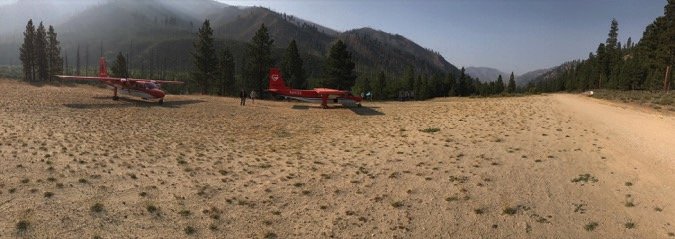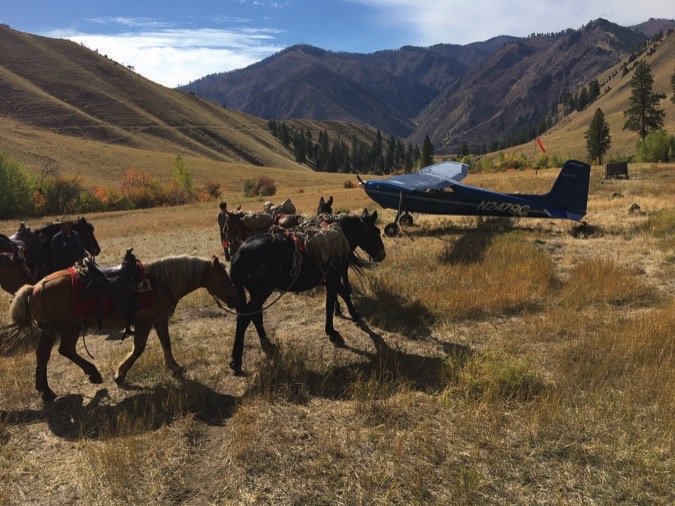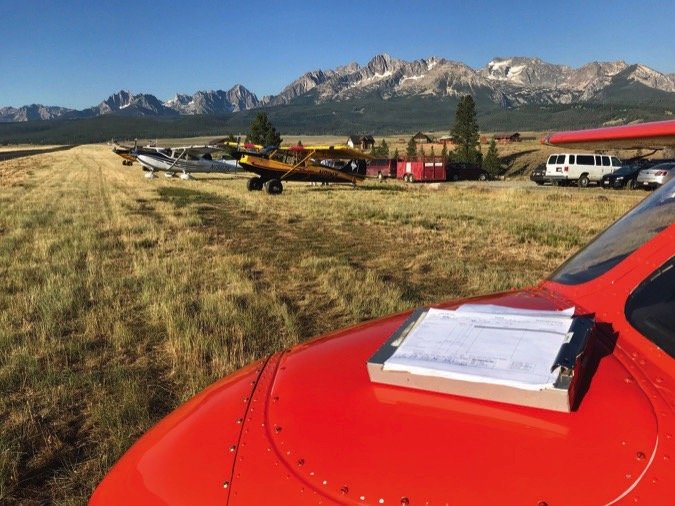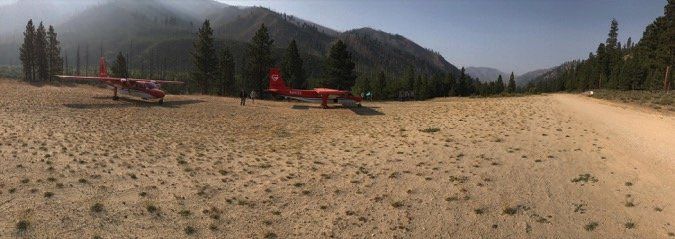
Many of today’s workplaces seek to create a formalized “safety culture,” an environment where employees practice behaviors that minimize accidents, look out for their co-workers and where reporting unsafe conditions is encouraged, not subject to retaliation, and frequently rewarded. It can be a great goal, but it often creates an exaggerated sense of safety where people need safety training to use a power strip and posters about how to get out of a car without tripping. The goal of creating a safety culture often ends up a corporate farce, since the best safety cultures are not created by artifice, but happen naturally because people really care.
In my experience, the community of pilots frequenting backcountry airspace, landing areas and frequencies over much of the mountain west has an endemic safety culture. It’s viral; it spreads by simple pilot-to-pilot contact. These safety-enhancing behaviors happened organically instead of being “managed” into existence.
Using their radios and their experience, backcountry pilots freely advise each other of safety concerns and tips on how to deal with challenging conditions at particular airstrips. After years immersed in corporate life and seeing the farcical versions of safety cultures, the level of mutual respect and helpfulness in the backcountry pilot community is refreshing. It may be something endemic to aviation in general, but I experience it in my daily life, which mostly involves mountain flying. The good news is that much of the backcountry safety culture applies other places I fly. The great news is it applies where you fly, too.
Backcountry Frequency
In much of the western U.S., 122.9 MHz is considered the “backcountry frequency.” If you are between airstrips and flying over empty terrain, this is the frequency you monitor and make occasional position reports. Lest you think let the vast amounts of empty terrain mean 122.9 is fairly quiet, you would be wrong.
In the early summer, big backcountry fly-ins at Smiley Creek, Johnson Creek, Big Creek and Garden Valley bring literally hundreds of pilots into the narrow canyons of Idaho. They gather together to meet with their communities, the Utah Backcountry Pilots,BackcountryPilots.org,Supercubs.org, the Cessna180 club, the RoundEngine Roundup and more. During fly-in season, 122.9 can be very busy, particularly at Johnson Creek.
Fly-in events are not inherently dangerous, but they concentrate pilots into confined spaces with limited options for maneuvering. That can, and does, lead to accidents. In Idaho, some of the more tragic accidents in recent years have occurred during fly-ins. One involved the classic scenario of a low-wing airplane descending onto a high-wing airplane on final. The mitigation for this accident is position reporting and using CTAF as you would at any airport, and following the traffic patterns and standard approaches. The Idaho Division of Aeronautics has published standard operating procedures (SOPs) for some of the more popular backcountry airstrips. Like the annual Notam for Oshkosh, these SOPs should be required reading, especially if you are unfamiliar with the airstrip you are heading into. An example of these published procedures is on page 14.
Reporting, not clogging
The VHF radio present a challenge to position reporting in mountainous terrain because is line-of-sight. You can try to report that you are two miles from Indian Creek or Wilson Bar, but if you are in the canyon and approaching pattern altitude for these airstrips, you may not be heard by the folks on the actual runway. The cliff or canyon wall that keeps you from being heard by the pilot who is about to depart the airstrip means he will be completely unaware of danger. For this and other reasons, it’s important to first overfly the airport. You want to know if anyone is on the ground and, if so, whether they’re departing or in the way, since many of the smaller airstrips have limited space for parking or even turning around. The most important radio call at any backcounty airstrip is the one you make when you have the airstrip in your field of vision. If you can’t see it, they (the pilots on the ground) can’t hear you.
The line-of-sight issue with radio calls also presents other challenges. The pilots who are chatting on the frequency in one canyon, for ex ample, Johnson Creek, can’t hear pilots chatting on the frequency one ridge over. It is convenient for them because all the backcountry airstrips in Idaho are on one frequency, 122.9. When you are transiting across at 11,500 feet, however, you get to hear all of the traffic and, at even higher altitudes, the frequency can be almost continuous banter and blocked transmissions.
Save long conversations like, “Where do you want to go next?” for an air-to-air frequency. You will frequently hear pilots suggest going to other frequencies for longer coordination discussions, for example at 122.72, 122.75, “fingers” 123.45, “high bond” 130.07 or “low bond” 120.07 (none of these frequencies is officially sanctioned; the FAA allocates 122.75 MHz for “air-to-air” use). By shifting coordinating conversations off a busy frequency, you will enhance the safety of others making critical position reports. But be sure to come back soon to the party line.
Deceptively and Unconventionally Busy
In the summer, backcountry airstrips providing access to river sports and wilderness activities can be extremely busy. Schaefer Meadows in Montana’s Bob Marshal Wilderness provides access for hikers, horseman and boaters to launch river trips into the wilderness or down the remote Middle Fork of the Flathead. Along the Middle Fork and Main Salmon Rivers in Idaho, boaters use air taxis for both put-ins and take-outs. Along the Snake River that divides Idaho from Oregon, airstrips are commonly used to access the river.
When the Frank Church River of No Return Wilderness was created, airstrips in regular use at the time of wilderness designation were grandfathered in to provide critical access to this remote country. Like any trailhead access point, they can become quite busy at the height of the summer vacation season. But unlike other airports, you can and should expect a busy mix of unconventional traffic.
When the Middle Fork of the Salmon is at low water, the U.S. Forest Service airstrip at Indian Creek (S81) is the busiest airport in the state of Idaho, beating Boise’s Gowan Field by a substantial number of daily operations. The nearby airport in Stanley, Idaho, is similarly busy. Stationairs, Islanders, Centurions, Caravans and a variety of tailwheel aircraft converge from all directions, and often multiple plane loads of aircraft arrive at the same time. Unlike Gowan Field, it is up to folks in the air to safely deconflict and coordinate landings and takeoffs.
Likewise, various locations in Alaska’s bush and even rural airports near you can see high rates of seasonal traffic, some of it centered around special events, like pancake breakfasts or fly-ins. And just as with backcountry flying, there are always local customs, topographic information and specific frequencies to bone up on.
Reporting Points
One problem with on-frequency backcountry position reporting is that pilots often reference locations that are not well-known to non-locals. But just as it is incumbent on pilots to be familiar with reporting points in Class Bravo VFR corridors, the same is true for the backcountry. If a landmark is named on a sectional, you should be familiar enough to know its location or know it is not something near your flight path. It may even mean spending some extra time studying the topography. For example, I know that when one pilot reports north of Big Baldy, another reports over Thomas Creek and another over Pistol Creek, all three are converging on Indian Creek. You can figure that out by studying the chart ahead of time, but knowing it in the air will help you deconflict and sort out the sequencing before three or five planes converge on a runway at the bottom of a canyon.
If you are flying in any backcountry area, you should be prepared beforehand by knowing the most common reporting points. If you hear someone call out one that you don’t know, and the signal is strong or the altitudes might converge, ask for clarification. It is always better to deconflict by asking.
Too Quiet
One early morning this past summer, I was headed west to pick up passengers, flying in trail with three other pilots. I was enjoying the smooth air, the sunrise on the peaks and the lack of aircraft on the frequency. The silence was broken when one of my companions bringing up the rear made a position report, then added “It’s quiet, a bit too quiet.” His prompt brought to life the two other airplanes with their position reports. Afterward, we discussed it, and he made the point that sometimes, when the airwaves are silent, we can easily think we don’t need to report our position because no one else is out there. It was an editorial comment, but non-reporting is a safety issue. Report your position, even when you feel like no one out there is listening—you might discover you are not alone.
One of the best ways to be a safer mountain pilot is to participate in the safety culture. You will learn a lot of safety tips by participating in online forums, attending fly-ins or just hanging out on the ramp. The same is true if you’re not planning to fly the backcountry, but just want to get to know the airports near you. Local pilots and FBO waiting rooms are a font of critical safety information that can include recent or historic accidents, and local information will give you added insights into the hazards associated with a particular area or airstrip.
I am a safer mountain pilot becauseI have the habit of engaging and listening. I know to not turn up a certain creek, or depart another strip before the sun is in my face, to check both windsocks and watch the power lines at a third. I learned these things through the informal network that sprang up—by necessity—among other pilots using the same airports. You can too because story-telling is part of our safety culture. Often, all you have to do is ask.
Word of Mouth

One place you can see, and hear, this backcountry safety culture in action is on the sidelines at various airports, especially while commercial pilots are waiting to load or unload gear and passengers. To the uninitiated, the stories they hear might sound like bragging or tall tales. Mountain pilots, in particular, tell stories that seem ripe for fabrication and exaggeration. But I have found the opposite.
When I hear pilots talking, about accidents or their own experiences, the hinge point of the story generally turns on what went wrong, how they could improve or the tips about things to watch for to avoid trouble. And in my experience, mountain pilots tend to be more concerned about safety than most. The stories we exchange are often told as a service to the community.
The sidelines at a backcountry airport during summer is a place where commercial mountain pilots share lessons learned and safety tips. You will find the same culture along the sidelines of many mountain strips in western U.S., if perhaps not the big-city FBOs.
Fingers Can Kill You

Here’s a classic pilot safety culture story: Two pilots flying different airplanes in a canyon indicated their desire for further discussion on frequency by saying, “Go to fingers,” the VHF frequency 123.45 MHz. This itself is a good safety practice, freeing up the main frequency for position reports. Their transmission was immediately followed by the disembodied voice of an old-timer who said, “Fingers can kill you.”
The old-timer was not making a chastising remark, nor did he make it with a snide or sarcastic tone. It was simply a good safety tip by an experienced pilot who has been flying the backcountry for 40 years or more. When flying in canyons, chatting on frequency can distract you from terrain. So leaving the main frequency to chat enhances the safety of others, but puts the chatting pilots at slightly higher risk. Fingers can be good, but fingers can kill you.
Overflying the Airstrip

There are plenty of other reasons to overfly an airstrip where you intend to land besides the line-of-sight radio limitation. While I was on a check flight with the USFS to be carded for backcountry and mountain flying, the check airman asked—in the check-airman kind of way—what exactly do I look for when overflying. It was not a trick question, but part of his evaluation. He wanted to make sure I knew what I should be looking for when overflying a backcountry strip. Here are just a few of those things, which can apply at any non-towered airport:
• What does the windsock say? Are there multiple windsocks? Do they agree?
• Are there other aircraft? Perhaps taxiing to take off, possibly disabled or occupying critical tie-down or turn-around areas?
• Can you plan your ground movements now to minimize your impact on others? Where are you going to park?
• Are there any animals, wildlife or pack stock near the runway?
• What are the obstructions for arrival and departure? Will you need a steep approach? Are trees, cliffs or water near the approach or departure likely to create wind burbles or sinking air?
• If there are multiple aircraft occupying minimal parking or staging areas, what will be your sequence?
• Presuming you can get in, can you get out?
Elk, Dirtbikes and Horses, Oh My
Unlike traditional airports with controlled access to aviation areas, backcountry strips are quite active with wildlife, campers, boaters, horseback riders, livestock and other recreationists. These novel hazards can occur all along the airstrip. Even quiet private strips can have unconventional activity. When used for recreational access, airstrips abound with people who aren’t necessarily accustomed to landing aircraft, the danger of spinning props and propwash. Pilots have to be extra vigilant.
My first go-around this year was coming into Mackey Bar, a short private airstrip where you don’t see the runway until you are literally a few yards from your touchdown spot. I scouted from overhead and saw nothing to be concerned with and made my initial calls, but as I came around the blind corner for my touchdown, a young man on a motorcycle was careening down the runway. I added power, retracted flaps and went around. Sometimes the visitors are so frequent, they are infamous, like the horse affectionately named Speed Bump that used to frequent the airstrip at Minam River Lodge.
Mike Hart flies his Piper J3 Cub and Cessna 180 when he’s not schlepping people and their gear. He’s also the Idaho State Liaison for the Recreational Aviation Foundation.




